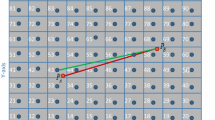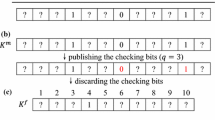Abstract
Secure hamming distance computation occupies a vital position in secure multiparty computation, which allows two parties to jointly compute the hamming distance without disclosing their respective private information. There are a lot of significant applications of secure hamming distance computation in private similarity determination fields, such as in biometric identification and e-commerce. In this paper, we present two quantum protocols for secure hamming distance computation. Protocol I subtly makes use of quantum CNOT operator and quantum Shift operator, which are simple quantum operators, while Protocol II utilizes the features of measurement-device-independent quantum key distribution, which can solve the security loopholes in practical realizations due to the imperfection in the detectors. Both two protocols can ensure the fairness of two parties and a higher security than the classical related protocols.

Similar content being viewed by others
Explore related subjects
Discover the latest articles and news from researchers in related subjects, suggested using machine learning.References
Yao, A.C.: Protocols for secure computations. In: 23rd Annual Symposium on Foundations of Computer Science, SFCS’08, pp. 160–164. IEEE (1982)
Goldreich, O., Micali, S., Wigderson, A.: How to play any mental game. In: Proceedings of the Nineteenth Annual ACM Symposium on Theory of Computing, pp. 218–229. ACM (1987)
Chaum, D., Crépeau, C., Damgard, I.: Multiparty unconditionally secure protocols. In: Proceedings of the Twentieth Annual ACM Symposium on Theory of Computing, pp. 11–19. ACM (1988)
Du, W., Atallah, M.J.: Secure multi-party computation problems and their applications: a review and open problems. In: Proceedings of the 2001 Workshop on New Security Paradigms, pp. 13–22. ACM (2001)
Bringer, J., Chabanne, H., Patey, A.: Shade: secure hamming distance computation from oblivious transfer. In: International Conference on Financial Cryptography and Data Security, pp. 164–176. Springer, Berlin, Heidelberg (2013)
Bringer, J., Chabanne, H., Favre, M. et al.: GSHADE: faster privacy-preserving distance computation and biometric identification. In: Proceedings of the 2nd ACM Workshop on Information Hiding and Multimedia Security, pp. 187–198. ACM (2014)
Kiraz, M.S., Genç, Z.A., Kardas, S.: Security and efficiency analysis of the Hamming distance computation protocol based on oblivious transfer. Secur. Commun. Netw. 8(18), 4123–4135 (2015)
Yasuda, M.: Secure Hamming distance computation for biometrics using ideal-lattice and ring-LWE homomorphic encryption. Inf. Secur. J. A Glob. Perspect. 26(2), 85–103 (2017)
Jarrous, A., Pinkas, B.: Secure Hamming distance based computation and its applications. In: ACNS, vol. 9, pp. 107–124 (2009)
Osadchy, M., Pinkas, B., Jarrous, A. et al.: Scifi-a system for secure face identification. In: Proceedings of the 2010 IEEE Symposium on Security and Privacy (SP), pp. 239–254. IEEE (2010)
Huang, Y., Evans, D., Katz, J. et al.: Faster secure two-party computation using garbled circuits. In: USENIX Security Symposium, vol. 201(1). (2011)
Blanton, M., Gasti, P.: Secure and efficient protocols for iris and fingerprint identification. In: European Symposium on Research in Computer Security, pp. 190–209. Springer, Berlin, Heidelberg (2011)
Kulkarni, R., Namboodiri, A.: Secure hamming distance based biometric authentication. In: 2013 International Conference on Biometrics (ICB), pp. 1–6. IEEE (2013)
Shor, P.W.: Algorithms for quantum computation: Discrete logarithms and factoring. In: Proceedings of the 35th Annual Symposium on Foundations of Computer Science, pp. 124–134. IEEE (1994)
Grover, L.K.: A fast quantum mechanical algorithm for database search. In: Proceedings of the Twenty-Eighth Annual ACM Symposium on Theory of Computing, pp. 212–219. ACM (1996)
Lo, H.K.: Insecurity of quantum secure computations. Phys. Rev. A 56(2), 1154 (1997)
Colbeck, R.: Impossibility of secure two-party classical computation. Phys. Rev. A 76(6), 062308 (2007)
Buhrman, H., Christandl, M., Schaffner, C.: Complete insecurity of quantum protocols for classical two-party computation. Phys. Rev. Lett. 109(16), 160501 (2012)
Nielsen, M., Chuang, I.: Quantum Computation and Quantum Information. Cambridge University Press, Cambridge (2000)
Lo, H.K., Curty, M., Qi, B.: Measurement-device-independent quantum key distribution. Phys. Rev. Lett. 108(13), 130503 (2012)
Bennett, C.H., Brassard, G.: Quantum cryptography: public key distribution and coin tossing. In: International Conference on Computer System and Signal Processing, pp. 175–179. IEEE (1984)
Bennett, C.H.: Quantum cryptography using any two nonorthogonal states. Phys. Rev. Lett. 68(21), 3121 (1992)
Wang, X.B.: Quantum key distribution with two-qubit quantum codes. Phys. Rev. Lett. 92(7), 077902 (2004)
Acknowledgments
This work was supported by National Natural Science Foundation of China (No. 61772001).
Author information
Authors and Affiliations
Corresponding author
Rights and permissions
About this article
Cite this article
Peng, Zw., Shi, Rh., Wang, Ph. et al. Two quantum protocols for secure hamming distance computation. Quantum Inf Process 18, 29 (2019). https://doi.org/10.1007/s11128-018-2140-2
Received:
Accepted:
Published:
DOI: https://doi.org/10.1007/s11128-018-2140-2




